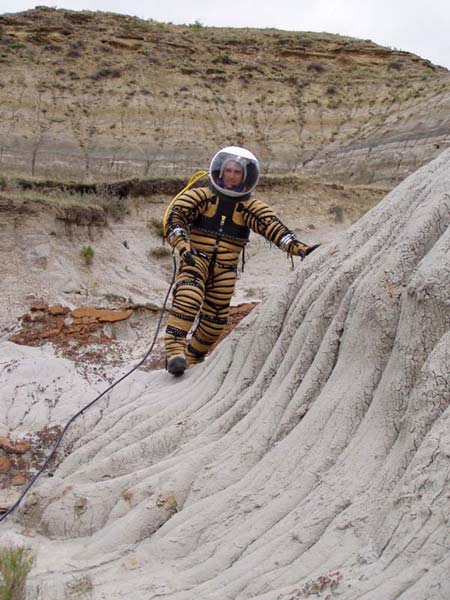Mars Spacesuit Prototype Trials Underway in North Dakota

A spacesuitprototype designed for Mars exploration is bounding across the North Dakotabadlands this week in a series of field tests to check its mobility and performance.
Engineersand university students are putting their North Dakota Experimental PlanetarySpace Suit through a series of challenges, including mock-Martian hikes, samplecollections and - this Saturday - a simulated sandstorm.
The Marsspacesuit is the culmination of 14 months of work by faculty and students withthe North Dakota Space Grant Consortium, which received $100,000 from NASA todevelop the prototype. [The local public is invited to view the Mars spacesuitin action on Sat. May 6, weather permitting, at its North Dakota test site.Click herefor directions.]
"It'sactually going much better than we expected," said Pablo de Leon, the project'smanager, during a telephone interview. "This terrain, it's probably verysimilar to some of the places on Mars."
The newsuit just one effort to advance human space exploration outside the safety of aspacecraft. Researchers at the Massachusetts Institute of Technology, forexample, are developing a Bio-SuitSystem as a potential future spacesuit.
The NorthDakota Space Grant Consortium includes the University of North Dakota, theNorth Dakota State College of Science, Turtle Mountain Community College,Dickinson State University and North Dakota State University.
Aplanetary spacesuit
Get the Space.com Newsletter
Breaking space news, the latest updates on rocket launches, skywatching events and more!
Anexperienced spacesuit designer and former Ansari XPrize contender, de Leon and his team have assembled a 50-pound (23kilogram) spacesuit - without the life support backpack - that can be sealedand pressurized, locking its inhabitant behind a helmet and six layers ofprotective fabric. A backpack containing communications equipment is equal insize to current life support units used in NASA suits today, the team said.
The result,researchers hope, is a planetary spacesuit smaller than thoseused in Earth orbit by NASA and Russia's Federal Space Agency, and moreflexible than NASA's Apollolunar spacesuits, the only other garments to be worn on another world.
"We wantedto really concentrate on the suit to improve mobility and to create a planetaryspacesuit instead one for zero [gravity]," de Leon said. "We're trying tocontain the human body in what is essentially a balloon of anthropomorphicform."
Whenspacesuits are pressurized with air they can become stiff, making simple fingermovements a chore for astronauts in space or on another world, he added. Thegoal is to reduce the amount of effort required simply to move on Mars, wherefuture explorers will likely stage many extravehicular activities (EVAs) andhave reuse and repair their own spacesuits, de Leon said.
One of theprototype's most noticeable features is a bright blue covering, designed forthermal protection and to guard against dust, which can be removed.
"I believethat one of the biggest challenges is going to be dustcontainment," de Leon said, adding that the prototype's dust jacket may notbe enough for Mars explorers. "The particles on Mars are very small, liketalcum powder. So it's going to be challenging to do several EVAs and maintaina good level of containment."
Donningthe prototype
Field testsfor the Mars prototype suit began May 1, with space studies graduate studentFabio Sau tucked inside the prototype from the start.
"It's avery personalized suit," Sau told SPACE.com from the North Dakotabadlands test site. "They built the suit based on my measurements."
Sau saidthe suit, which has performed great so far, comes in two primary pieces splitat the waist between upper torso and lower body. Helmet and glove attachmentscomplete the outfit, which is then pressurized to about 1 pound per square-inch(psi) for tests, he added.
Forcomparison, NASA spacesuits are pressurized up to 4.3 psi while their RussianOrlan counterparts are set at 5.8 psi.
"The mostdifficult part is entering the upper torso," Sau said, adding that from startto finish he can don the suit in 15 minutes with some help from his colleagues.
Sau saidgetting the opportunity to work with actual hardware has been an amazingexperience, which de Leon hopes will encourage other university students topursue humanspaceflight-related careers.
"The maininterest of NASA when they gave us this grant was to train the new generationof space studies students and engineers, because [they are] going to be theworkforce for the future missions," de Leon said. "The [spacesuit] improvementwe've seen is very significant, but of course we still have a long way to go."
- Report: NASA Workforce Needs Fresh Recruits
- Martian Dust Major Risk to Manned Mission
- High-Tech Spacesuits Eyed for 'Extreme Exploration'
- NASA's New Moon Plans: 'Apollo on Steroids'
Join our Space Forums to keep talking space on the latest missions, night sky and more! And if you have a news tip, correction or comment, let us know at: community@space.com.

Tariq is the Editor-in-Chief of Space.com and joined the team in 2001, first as an intern and staff writer, and later as an editor. He covers human spaceflight, exploration and space science, as well as skywatching and entertainment. He became Space.com's Managing Editor in 2009 and Editor-in-Chief in 2019. Before joining Space.com, Tariq was a staff reporter for The Los Angeles Times covering education and city beats in La Habra, Fullerton and Huntington Beach. In October 2022, Tariq received the Harry Kolcum Award for excellence in space reporting from the National Space Club Florida Committee. He is also an Eagle Scout (yes, he has the Space Exploration merit badge) and went to Space Camp four times as a kid and a fifth time as an adult. He has journalism degrees from the University of Southern California and New York University. You can find Tariq at Space.com and as the co-host to the This Week In Space podcast with space historian Rod Pyle on the TWiT network. To see his latest project, you can follow Tariq on Twitter @tariqjmalik.









